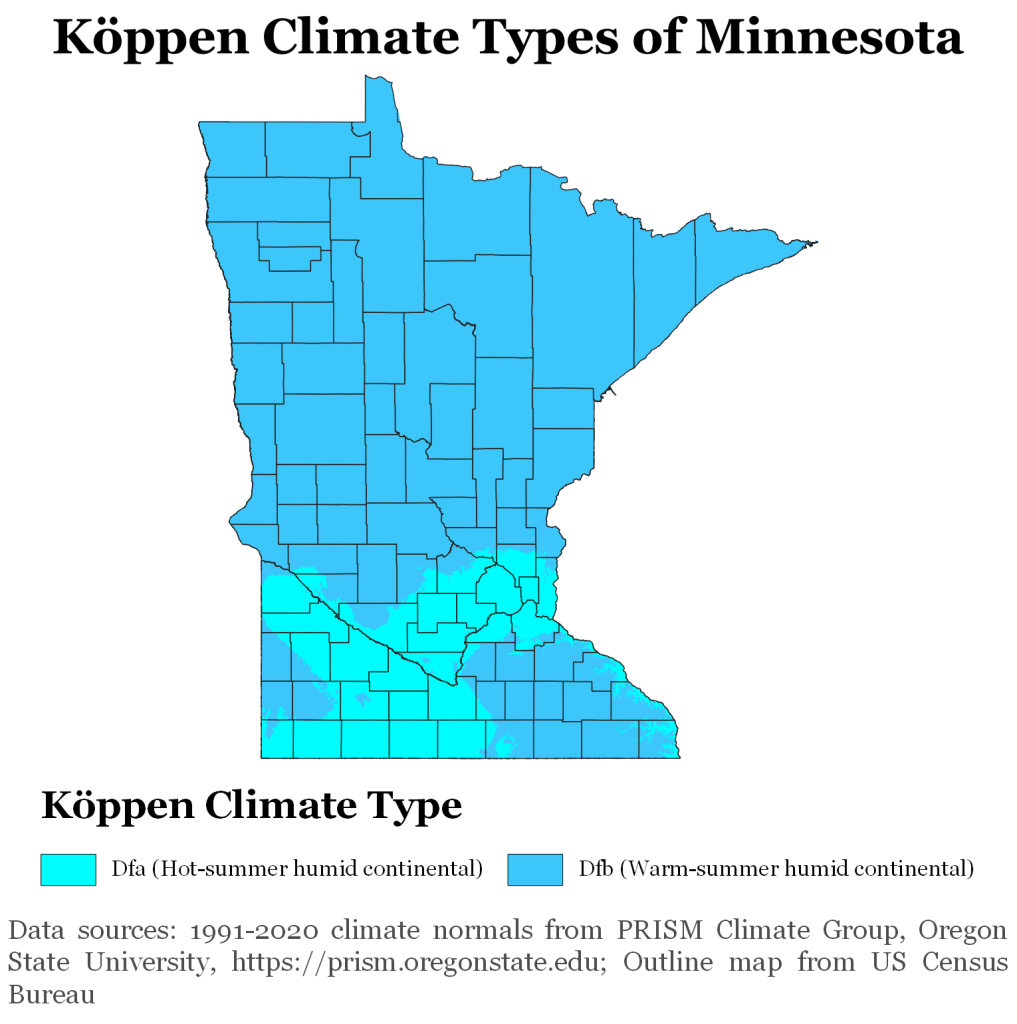Minnesota Plant Hardiness Zones
| USDA Hardiness Zone | Average Minimum Extreme Winter Temperature Range Fahrenheit (°F) Celsius (°C) | Average Last Frost Date Range In Spring (Beginning Of The Growing Season) | Average First Frost Date Range In Autumn (End Of The Growing Season) |
|---|---|---|---|
| 3a | -40°F to -35°F -40°C to -37.2°C | Mid to Late May | Early to mid-September |
| 3b | -35°F to -30°F -37.2°C to -34.4°C | Mid to Late May | Early to mid-September |
| 4a | -30°F to -25°F -34°C to – 31.7°C | Mid to Late May | Early to mid-September |
| 4b | -25°F to – 20°F -31.7°C to -28.9°C | Mid to Late May | Mid to Late September |
| 5a | -20°F to -15°F -28.9°C to -26.1°C | Early to mid-May | Late September to Early October |
Minnesota Growing Conditions

Credit to Wikipedia
General Climate
The Koppen climate classification characterizes Minnesota as a humid continental climate. This means the state has four distinct seasons, each with large fluctuations of temperatures.
There are two distinct zones within the state. These vary between a hot summer zone and a warm summer zone.
The southern part of the state, from Twin Cities down, gets hot and humid during the summer. The northern part of the state, on the other hand, experiences warm summers that are less humid.
The area of the state that borders Lake Superior has unique weather. Proximity to Lake Superior moderates the climate. It creates cooler summers and warmer winters with less variation in extreme temperature.
This area can also experience lake-effect, which increases precipitation in the form of snow during the winter months.
Lake-effect occurs when cold air moves over large, warmer bodies of water, like the Great Lakes. The heat and moisture cause clouds to form, creating precipitation in the form of heavy snow. This process causes large amounts of snow to fall in a short period of time.
Minnesota receives most of its precipitation from May through October. Although, each year the state faces longer periods of prolonged drought.
Microclimates
USDA plant hardiness zones are an important starting point for your garden, but you’ll also need to consider microclimates.
Microclimates are areas where specific conditions create a climate different from the climate they are situated in.
Buildings, fences, paved areas, or short hills and valleys can create these microclimates.
They can be as small as a space in your backyard or as large as a city.
In other words, learn about your local conditions from local experts to see if your garden falls into a microclimate.
Extreme Weather
Tornados
Minnesota experiences an average of 27 tornados a year. Peak tornado season is June through August, but the state can see tornadoes from March through November.
Tornados are more common in the southern parts of the state. This area falls within the northern range of Tornado Alley.
Choosing plants with strong root systems is one way to keep your garden intact during the erratic, destructive tornado season.
Drought
For gardeners in Minnesota, increased annual drought is a growing concern for food production.
The southern part of the state experiences a higher chance of drought compared to the north.
Minnesota experiences the most precipitation from May to early October. Unfortunately, with increasing periods of drought, the lack of rain is having a detrimental impact on the growing season.
Effects of drought can cause plant wilt, burning of leaves, and even mass plant death if sufficient irrigation is not set up.
Drip irrigation is the most sustainable and conservative form of irrigation. It reduces the amount of water evaporation that can occur compared to overhead watering systems.
Applying mulch over the top of drip irrigation is also a great way to conserve and retain water in the garden.
Setting up irrigation is important during seasons of drought.
Choosing drought tolerant plants is the best choice when planning your garden for the future climate of Minnesota.
Growing Season
Minnesota has a short growing season with an average of 125 days of frost-free growing. The northern portion of the state sees as little as 90 days a year, while the far south experiences around 160 days.
Most veggies require more than 90 days of growing to reach maturity. This means it’s important to understand growing schedules to take full advantage of the season.
Greenhouses and cold frames can help extend the growing season in the north. They create a warmer climate for growing veggies like tomatoes and peppers, which are more challenging to grow in short growing seasons.
For flowers, cold hardy annuals will be your best bet for adding color to the garden. These flowers can be sown in the fall, to overwinter in the garden and get a head start on the growing season.
Evergreen shrubs and trees help by adding year round foliage and structure to your garden.
Minnesota Gardening Tips

Growing Season Extenders
Minnesotians describe their growing season as too short! Below are some tools and methods to help you extend the short growing season.
Mulch
Using mulch in your garden warms the soil. This helps newly transplanted seedlings and directly sown seeds get a head start on growing.
Mulch creates a warmer and more consistent soil temperature. This aids in seed germination and helps protect newly transplanted seedlings from colder weather.
Row Cover
Using row cover on your garden also aids in successful seed germination and protects your plants.
Row cover is a lightweight material that you place on top of your plants. It is light enough that sun and rain are able to penetrate through, while thick enough to create a warmer environment. It also protects against insects.
Like mulch, row cover creates a more consistent, warm environment. Thus allowing new seedlings and directly planted seeds to thrive.
These methods help extend the growing season by giving gardeners an earlier start as well as allowing continual harvesting later in the season.
Cool Season Vegetables
With Minnesota’s short growing season, cool season vegetables are a valuable form of food production.
Salad greens like lettuce, spinach, and kale have a short growing period. They can be directly sown in cool weather and can be succession planted throughout the season.
Choosing vegetables like these and using the tips above is a great way to extend the growing season.
Consult With Local Professionals
Consulting with local gardening professionals allows you to benefit from their experience with your area’s conditions, the plants that do well there, and overall best practices.
Minnesota Plant Suggestions

Trees
- River Birch (Betula nigra)
- Northern Catalpa (Catalpa speciosa)
- White Pine (Pinus strobus)
Shrubs
- Bush Honeysuckle (Diervilla lonicera)
- Bush Juniper (Juniperus communis var. Depressa)
- Smooth Wild Rose (Rosa blanda)
Flowers
- Rough Blazing Star (Liatris aspera)
- Stiff Coreopsis (Coreopsis palmata)
- Little Bluestem (Schizachyrium scoparium)
Vegetables
- Lettuce (Lactuca sativa)
- Curly Leaf Kale (Brassica oleracea Acephala)
- Spinach (Spinacia oleracea)
Herbs
- Chives (Allium schoenoprasum)
- Mint (Lamiaceae)
- Borage (Boraginaceae)
Spices
- Parsely (Petroselinum crispum)
- Cilantro (Coriandrum sativum)
- Fennel (Apiaceae)
Fruits
- Lowbush Blueberry (Vaccinium angustifolium)
- Wild Plum (Prunus americana)
- Red Raspberry (Rubus idaeus subsp. strigosus)
Succulents
- Eastern prickly pear (Opuntia humifusa)
- Hen and Chicks (Sempervivum tectorum)
- Sedum ‘Autumn Joy’ (Hylotelephium telephium)
Disclaimer
Any of the above can change and is not exhaustive.
Treat anything above like a good starter guide. Then use that as a foundation as you consult with local gardeners, professionals, forecasts, guides, and organizations.

